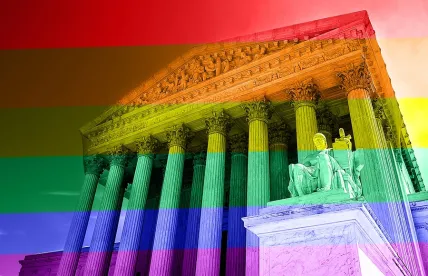To illustrate why an employer violates federal employment law by discriminating against gay, lesbian, bisexual, and transgender (LGBT) people, the United States Supreme Court majority told the stories of Hannah and Bob. More on Hannah and Bob later.
In its sweeping 6-3 decision, the Court today ruled that Title VII of the Civil Rights Act of 1964 prohibits discrimination against individuals on the basis of their sexual orientation or gender identity/transgender status, holding that such discrimination is, inherently, “because of sex.” While 21 states and a number of localities have laws prohibiting job discrimination on the basis of sexual orientation or gender identity, the Supreme Court’s decision expands federal protections to all U.S. workers for the first time.
The Court’s opinion considered two lines of cases, one concerning claims by gay men alleging they were fired because of their sexual orientation, and the second by a transgender woman claiming her former employer fired her when she announced at work her intention to transition her gender identity from male to female. Finding in the employees’ favor, the Court held that “[a]n employer who fires an individual for being homosexual or transgender fires that person for traits or actions it would not have questioned in members of a different sex. Sex plays a necessary and undisguisable role in the decision, exactly what Title VII prohibits.”
Among other categories, Title VII makes it unlawful for an employer with 15 or more employees to “fail or refuse to hire or to discharge any individual, or otherwise discriminate against any individual … because of such individual’s … sex.” The employers in these cases and the Trump administration argued that neither “sexual orientation” nor “gender identity” were terms or concepts contemplated by Congress when Title VII became law in 1964, and thus the term “sex” as used in the law could not be expanded beyond what Congress understood “sex” to mean at that time.
However, in analyzing the claims on statutory interpretation principles, rather than constitutional principles – as it had in its prior marriage decisions – the high Court rejected that proposition. In doing so, the Court looked to the ordinary meanings of the key terms within Title VII, including “sex,” “because of” and “discriminate.” In finding that “sex” refers to biological distinctions between male and female, and that the meaning of “because of” is “by reason of” or “on account of,” the Court held that “[b]ecause discrimination on the basis of homosexuality or transgender status requires an employer to intentionally treat individual employees differently because of their sex, an employer who intentionally penalizes an employee for being homosexual or transgender also violates Title VII.” In other words, an employer that discriminates on the basis of an employee’s sexual orientation or transgender status “inescapably intends to rely on sex in its decision-making.”
Discussing Hannah and Bob, the Court found it is impossible to discriminate against a person for being gay, lesbian, or transgender without discriminating against that person based on sex. When a gay or lesbian person such as Hannah or Bob is fired for loving a person of the same sex, or for presenting at work as the opposite sex into which they were born, then Hannah or Bob is being treated differently due to sex. Given the way Title VII is drafted and the plain meaning of the terms used in the statute, the Court held that there is no way around this conclusion.
This ruling is significant, as it expands Title VII protections to LGBT employees nationwide with immediate effect. Employers should quickly review their existing equal employment opportunity and harassment policies and update them to expressly include sexual orientation, gender identity and gender expression as protected characteristics. Employers should also ensure any employee training materials are fully inclusive of protections afforded LGBT employees under the Court’s ruling.
While the EEOC has been pursuing sexual orientation and transgender discrimination claims for some time, today’s ruling provides solid legal footing for the agency to continue doing so. Employers with outdated policies or training materials will have a more difficult time defending such claims.
We recommend employers immediately consult with legal counsel to ensure all applicable policies, procedures and materials are appropriately tailored to account for the Supreme Court’s expansion of protections for LGBT employees.





 />i
/>i
